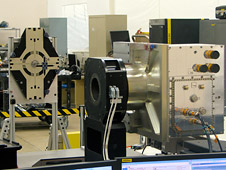Apr 5 2010
A technology that would, in the future, enable space vehicles to dock easily to the International Space Station was developed by the NASA contractors and engineers during the last two years.
 NASA's Five Retro-Reflectors Undergoing Lab Test
NASA's Five Retro-Reflectors Undergoing Lab Test
The docking camera, along with the vision navigation sensor (VNS), is capable of improving the required capability to enable automated rendezvous and docking of space vehicles with the space station. Houston-based Johnson Space Center of NASA has developed these two components through the Orion Project Office at NASA's Johnson Space Center in Houston.
The VNS, an eye-safe flash light detection and ranging (LiDAR) system, provides the target image, that is, the space station, as well as bearing and range data for precision. The docking camera has the capability to offer color images with high resolution.
Va-based NASA Langley Research Center designed five retro-reflectors made of reflective material like the one used for stop signs, form the base element of the technology. These reflectors will be launched on the STS-131 space mission on April 5 2010. They reflect light with a minimal scattering and will function as VNS’ targets.
During the STS-134 shuttle mission in July 2010, the new system will be demonstrated along with its docking, undocking and re-rendezvous activities. During these activities the mission crew will gather data and monitor the system by using the STORRM software application installed in the shuttle computer. Besides this, the data screen shots will also be transmitted through slow scan video to Johnson’s Mission Control so that the STORRM team will be able to analyze the data in real time.
The NASA Johnson and the NASA Langley teams, along with industry partners Ball Aerospace and Lockheed Martin, have jointly developed and tested the system prototype. The prototype development was based on directions from the Orion Project office. The prototype will provide support for the STORRM Development Test Objective. Langley engineers are responsible for design and build up of avionics, reflective elements, DTO computer hardware, engineering management, and also components integration, testing, and certification. Responsibilities of the NASA Johnson include contract management, program management, flight test objectives, data post-processing, technology evaluation, and operational concepts. Responsibility for designing, building, and testing of the docking camera and the VNS is with industry partners, namely, the Ball Aerospace Technology Corporation and the Lockheed Martin Space Systems.